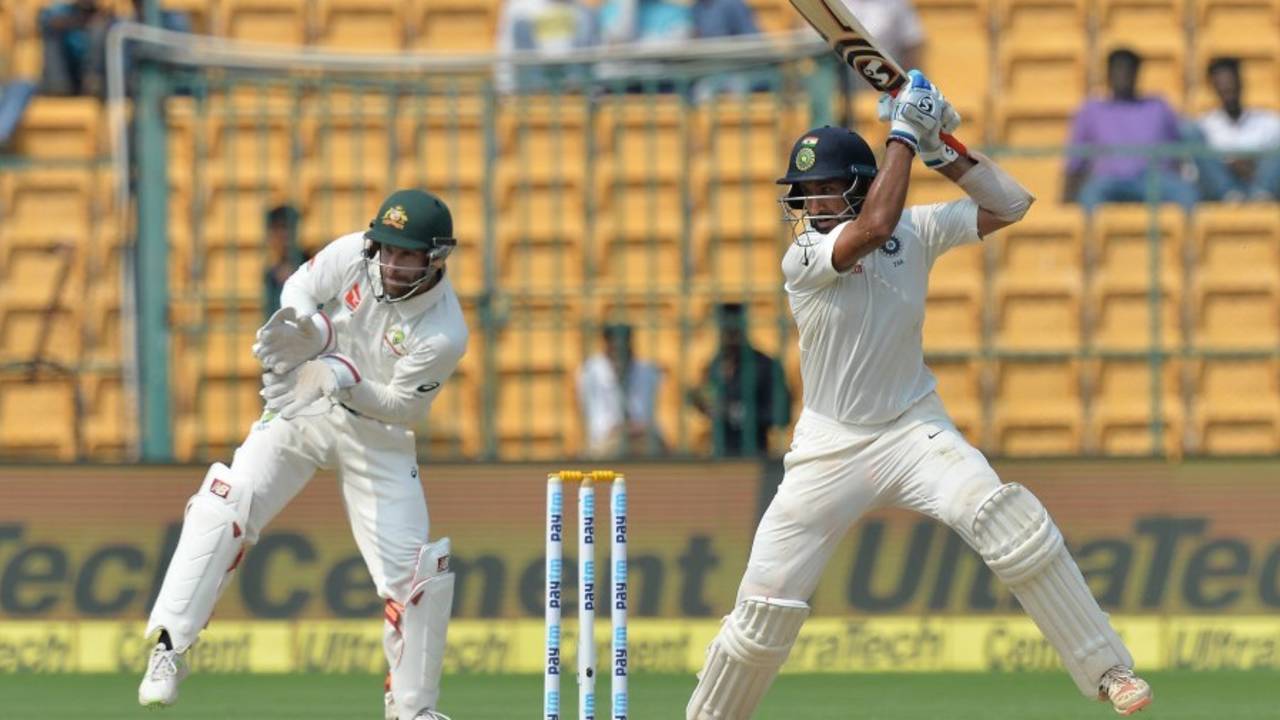Some of the highest points of
Cheteshwar Pujara's career have come while batting in the second innings of home Tests against Australian offspinners named Nathan.
In Pujara's
debut Test at the Chinnaswamy Stadium in October 2010, MS Dhoni promoted him from No. 6 to No. 3 when India were 17 for 1 chasing a potentially tricky 207. He responded with 72 off 89 balls, and India waltzed home at a run rate of 4.60. Of Pujara's 72 runs, 25 came off Nathan Hauritz, in 19 balls. Hauritz had come into the series on the back of a
good year in Test cricket, having made crucial contributions to wins against Pakistan in Sydney and New Zealand
in Wellington. Bangalore would be his last Test match.
Three years later, Pujara was one of seven batsmen dismissed by Nathan Lyon in India's first innings, after scoring 52 on a spiteful Feroz Shah Kotla pitch. Mitchell Johnson hit Pujara's glove with a lifter in that innings, and it was with a broken finger that he opened the batting in the second innings, with India chasing 155. India scored at more than five an over while hunting down their target, and Pujara ended up with an unbeaten 82 off 92 balls. This time, 31 of his runs, off 44 balls, came off Lyon.
By the time Pujara walked in to bat on Monday, he had faced Lyon 16 times in Tests - only James Anderson has bowled to him more often - and had been dismissed five times, more than by any other bowler. The fifth of Lyon's dismissals of Pujara had come two days previously, a bat-pad catch at short leg that was the first of the offspinner's eight first-innings wickets.
The situation was rather different to Bangalore 2010 or Delhi 2013. This was the third innings of a far more attritional game, and Australia were well ahead when Pujara strode in. India were 1-0 down in the series, and were now trailing by 48 runs on a crack-ridden pitch offering inconsistent bounce and turn.
Pujara began uncertainly against Lyon, twice playing inside the line of balls that didn't turn. Hauritz had bowled him with one such ball during his debut 72, and Lyon had bowled him with another in the first innings of the 2013 Delhi Test. This time, both balls kissed his outside edge; the first one kept low and hit the wicketkeeper's pad, and the second went to the left of slip, where Steven Smith dropped the sharp chance. In between, there was also a ball that jumped out of the rough, hit Pujara's inside edge and his pad, and fell wide of short leg.
It isn't clear whether what happened next was down to accident or design, but Pujara, having faced eight out of Lyon's first 12 balls when he was at the crease, only faced two of his next 24. KL Rahul, looking more comfortable than anyone should have on a pitch as challenging as this one, shielded his partner expertly.
By the time Rahul fell for 51, India's deficit was down to three runs. Pujara was now batting on 14 and looking slightly surer of his bearings. By tea, India had lost two more wickets but Pujara was still there, on 34.
Second ball after tea, Pujara danced down the pitch to Lyon, met the ball on the full, and stroked it to the cover point boundary. Forays down the track to drive against the turn had been a feature of both his 72 on debut and his unbeaten 82 at the Kotla, but this was the first and last time he would play such a shot during this innings, even though Lyon was bowling to a 6-3 leg-side field with a massive gap between backward point and mid-off. This wasn't a pitch for the flowing drive, with the ball not coming on to the bat and a straight, catching midwicket waiting for the inside edge or the uppish flick.
Pujara, instead, was making a conscious effort to play with the turn. By the time he went to stumps batting on 79, he would have only played two scoring shots into the off side against Lyon. Six of his seven scoring shots into the leg side against Steve O'Keefe either came when the left-arm spinner drifted down the leg side, giving him the chance to glance or paddle-sweep, or when defensive shots rolled into the leg side off the inside edge when the ball skidded through straight.
Through the age-old trick of getting his eye in, Pujara gradually grew comfortable against the spinners, his footwork a lot more decisive. The pitch, drier than it had been on Saturday, was also slower - Josh Hazlewood later said batsmen now had more time to adjust if the ball jumped or shot through low - and Pujara, as well as Rahul and Ajinkya Rahane, profited from staying on the back foot as much as they could against Lyon.
Against the quicks, who were now perhaps Australia's most potent weapons, Pujara hardly ever drove, and instead waited for balls on his pads or hints of width so he could use the pace and steer the ball to third man. Against Hazlewood, Mitchell Starc and Mitchell Marsh, he only scored six runs in front of square - all via clips through forward square leg - while scoring 25 behind the wicket. Hazlewood took three of India's four wickets, and Pujara ended up with a control percentage of 93 and a strike rate of 60 against him. His corresponding figures against Starc were 80 and 66.66.
This, then, was an innings built on simple, self-enforced limitations: don't drive, don't play against the turn, look to use the pace of the ball when the chance presents itself. It was an entirely different innings to Bangalore 2010 and Delhi 2013, but it had a not-too-dissimilar effect on Australia, and on their offspinner named Nathan.
Karthik Krishnaswamy is a senior sub-editor at ESPNcricinfo
